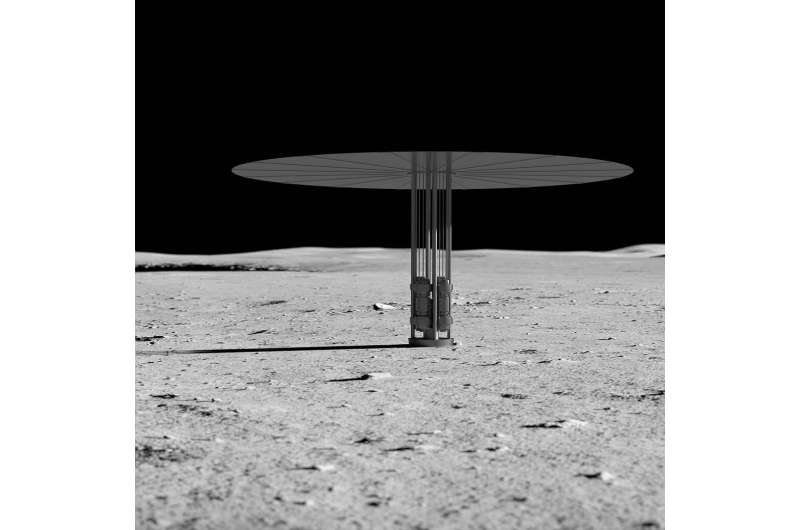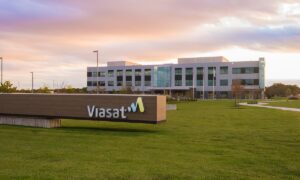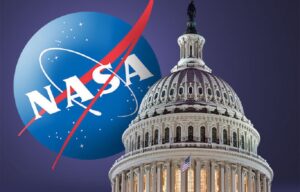NASA announces Artemis concept awards for nuclear power on moon
Wednesday, 22 June 2022 13:09
NASA and the U.S. Department of Energy (DOE) are working together to advance space nuclear technologies. The agencies have selected three design concept proposals for a fission surface power system design that could be ready to launch by the end of the decade for a demonstration on the moon. This technology would benefit future exploration under the Artemis umbrella.
The contracts, to be awarded through the DOE's Idaho National Laboratory, are each valued at approximately $5 million. The contracts fund the development of initial design concepts for a 40-kilowatt class fissionpower system planned to last at least 10 years in the lunar environment.
Relatively small and lightweight compared to other power systems, fission systems are reliable and could enable continuous power regardless of location, available sunlight, and other natural environmental conditions.
DoD Satcom: Big money for military satellites, slow shift to commercial services
Wednesday, 22 June 2022 13:00
Big money for military satellites signals a slow shift to commercial services.
The post DoD Satcom: Big money for military satellites, slow shift to commercial services appeared first on SpaceNews.
Viasat shareholders approve Inmarsat acquisition
Wednesday, 22 June 2022 12:42
Viasat said June 21 that its shareholders voted to approve its $7.3 billion plan to acquire British satellite operator Inmarsat.
The post Viasat shareholders approve Inmarsat acquisition appeared first on SpaceNews.
House bill trims NASA budget proposal
Wednesday, 22 June 2022 11:01
A draft House spending bill would provide NASA with a smaller spending increase than requested for fiscal year 2023, with cuts spread among exploration, science and technology programs.
The post House bill trims NASA budget proposal appeared first on SpaceNews.
SwRI scientists identify a possible source for Charon's red cap
Wednesday, 22 June 2022 10:56 Southwest Research Institute scientists combined data from NASA's New Horizons mission with novel laboratory experiments and exospheric modeling to reveal the likely composition of the red cap on Pluto's moon Charon and how it may have formed. This first-ever description of Charon's dynamic methane atmosphere using new experimental data provides a fascinating glimpse into the origins of this moo
Southwest Research Institute scientists combined data from NASA's New Horizons mission with novel laboratory experiments and exospheric modeling to reveal the likely composition of the red cap on Pluto's moon Charon and how it may have formed. This first-ever description of Charon's dynamic methane atmosphere using new experimental data provides a fascinating glimpse into the origins of this moo South Korea launches homegrown Nuri rocket in major space milestone
Wednesday, 22 June 2022 10:56 South Korea successfully launched its first homegrown rocket on Tuesday, deploying a satellite into low-Earth orbit in a major milestone as the country jumps into the space race with both commercial and military implications.
The three-stage Nuri rocket blasted off from the Naro Space Center in the southern coastal town of Goheung on Tuesday afternoon. It reached its target altitude of 435
South Korea successfully launched its first homegrown rocket on Tuesday, deploying a satellite into low-Earth orbit in a major milestone as the country jumps into the space race with both commercial and military implications.
The three-stage Nuri rocket blasted off from the Naro Space Center in the southern coastal town of Goheung on Tuesday afternoon. It reached its target altitude of 435 SwRI researcher shows how elliptical craters could shed light on age of Saturn's moons
Wednesday, 22 June 2022 10:56 A new SwRI study describes how unique populations of craters on two of Saturn's moons could help indicate the satellites' age and the conditions of their formation. Using data from NASA's Cassini mission, SwRI postdoctoral researcher Dr. Sierra Ferguson surveyed elliptical craters on Saturn's moons Tethys and Dione for this study, which was co-authored by SwRI Principal Scientist Dr. Alyssa Rhod
A new SwRI study describes how unique populations of craters on two of Saturn's moons could help indicate the satellites' age and the conditions of their formation. Using data from NASA's Cassini mission, SwRI postdoctoral researcher Dr. Sierra Ferguson surveyed elliptical craters on Saturn's moons Tethys and Dione for this study, which was co-authored by SwRI Principal Scientist Dr. Alyssa Rhod MOONRISE: LZH and TU Berlin bring 3D printing to the Moon with laser and AI
Wednesday, 22 June 2022 10:56 3D printing on the Moon: Scientists from the Laser Zentrum Hannover e.V. (LZH) and the Technische Universitat Berlin (TU Berlin) are planning a flight to the Moon to melt lunar dust with laser beams.
In the MOONRISE project, the research team wants to explore the question of how we can use lasers to build landing sites, roads or buildings out of lunar dust in the future. To do this, the re
3D printing on the Moon: Scientists from the Laser Zentrum Hannover e.V. (LZH) and the Technische Universitat Berlin (TU Berlin) are planning a flight to the Moon to melt lunar dust with laser beams.
In the MOONRISE project, the research team wants to explore the question of how we can use lasers to build landing sites, roads or buildings out of lunar dust in the future. To do this, the re Tyvak International completes Critical Design Review of Deep Space Bound Milani nanosat
Wednesday, 22 June 2022 10:56 Terran Orbital Corporation (NYSE: LLAP), a global leader in satellite solutions, primarily serving the aerospace and defense industries, has announced its wholly-owned subsidiary, Tyvak International SRL, has together with its partners, achieved full Critical Design Review of the Milani spacecraft.
A critical component of the Hera planetary defense mission,
Terran Orbital Corporation (NYSE: LLAP), a global leader in satellite solutions, primarily serving the aerospace and defense industries, has announced its wholly-owned subsidiary, Tyvak International SRL, has together with its partners, achieved full Critical Design Review of the Milani spacecraft.
A critical component of the Hera planetary defense mission, InSight gets a few extra weeks of Mars science
Wednesday, 22 June 2022 10:56 As the power available to NASA's InSight Mars lander diminishes by the day, the spacecraft's team has revised the mission's timeline in order to maximize the science they can conduct. The lander was projected to automatically shut down the seismometer - InSight's last operational science instrument - by the end of June in order to conserve energy, surviving on what power its dust-laden solar pan
As the power available to NASA's InSight Mars lander diminishes by the day, the spacecraft's team has revised the mission's timeline in order to maximize the science they can conduct. The lander was projected to automatically shut down the seismometer - InSight's last operational science instrument - by the end of June in order to conserve energy, surviving on what power its dust-laden solar pan Chinese official says its Mars sample mission will beat NASA back to Earth
Wednesday, 22 June 2022 10:56 A senior Chinese space official said on Monday the country is on track to bring back rocks from the surface of Mars two years ahead of the planned joint effort by NASA and the European Space Agency to do the same thing.
Sun Zezhou, the chief designer of China's first Mars mission, Tianwen 1, said in a talk celebrating the 120th anniversary of Nanjing University, that China is ready to send
A senior Chinese space official said on Monday the country is on track to bring back rocks from the surface of Mars two years ahead of the planned joint effort by NASA and the European Space Agency to do the same thing.
Sun Zezhou, the chief designer of China's first Mars mission, Tianwen 1, said in a talk celebrating the 120th anniversary of Nanjing University, that China is ready to send China develops new coating for spacecraft thermal control
Wednesday, 22 June 2022 10:56 Chinese scientists have developed a metallic-based thermal-control coating for the Shenzhou-14 crewed spaceship that will protect the taikonauts from extreme heat and cold during their six-month stay in orbit.
The new coating works in two ways: providing low solar absorption to help reduce the sun's effect on the spacecraft's interior temperature; and providing low infrared emittance to bl
Chinese scientists have developed a metallic-based thermal-control coating for the Shenzhou-14 crewed spaceship that will protect the taikonauts from extreme heat and cold during their six-month stay in orbit.
The new coating works in two ways: providing low solar absorption to help reduce the sun's effect on the spacecraft's interior temperature; and providing low infrared emittance to bl Go ahead for second round of micro-launcher payload competition
Wednesday, 22 June 2022 10:56 On 20 June 2022, the German Space Agency (DLR) launched the second round of its competition for zero-cost flights of small satellites on microlaunchers developed and constructed in Germany. This marks the start of the implementation phase for a total of three additional flights being offered by the space companies Isar Aerospace Technologies GmbH and Rocket Factory Augsburg AG in 2023 and 2024.
On 20 June 2022, the German Space Agency (DLR) launched the second round of its competition for zero-cost flights of small satellites on microlaunchers developed and constructed in Germany. This marks the start of the implementation phase for a total of three additional flights being offered by the space companies Isar Aerospace Technologies GmbH and Rocket Factory Augsburg AG in 2023 and 2024. A blueprint for life forms on Mars
Wednesday, 22 June 2022 10:56 The extremely salty, very cold, and almost oxygen-free environment under the permafrost of Lost Hammer Spring in Canada's High Arctic is the one that most closely resembles certain areas on Mars. So, if you want to learn more about the kinds of life forms that could once have existed - or may still exist - on Mars, this is a good place to look.
After much searching under extremely difficul
The extremely salty, very cold, and almost oxygen-free environment under the permafrost of Lost Hammer Spring in Canada's High Arctic is the one that most closely resembles certain areas on Mars. So, if you want to learn more about the kinds of life forms that could once have existed - or may still exist - on Mars, this is a good place to look.
After much searching under extremely difficul Students take their imagination to the lunar surface in the latest Moon Camp Challenge
Wednesday, 22 June 2022 10:56 From a base built by rovers and astronauts using in-situ resources at the lunar south pole to a north pole facility with surface and subsurface living/working areas, the 2021-2022 Moon Camp Challenge's winning projects once again highlighted students' ability to envision the future of space exploration.
This fourth edition of the Moon Camp Challenge involved a record participation of 5,649
From a base built by rovers and astronauts using in-situ resources at the lunar south pole to a north pole facility with surface and subsurface living/working areas, the 2021-2022 Moon Camp Challenge's winning projects once again highlighted students' ability to envision the future of space exploration.
This fourth edition of the Moon Camp Challenge involved a record participation of 5,649 
